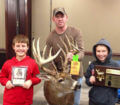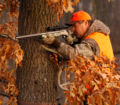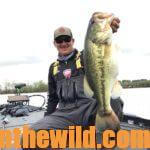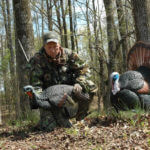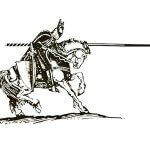John’s Note: The hunters who score deer year after year know the truth – you have to give Lady Luck a helping hand. Here’s how!
After hunting with and interviewing some of the best white-tailed deer hunters in the nation, I have learned that consistent deer hunting is not comprised of some magical technique or mystical power that the best hunters possess. Actually the deer hunters who regularly bag the most deer each season are the sportsmen who always do things right. Hunting the right way is not one secret method but rather is a combination of doing many little things correctly.
 Although green fields, acorn flats, cornfields and other food sources are ideal places to take whitetails, during hunting season as hunting pressure builds-up, oftentimes the deer will feed in these obvious areas at night when the hunters are at home asleep. If we can remember that survival is the buck’s primary concern, then we can learn better how to hunt him. To survive, the deer must stay in cover – even if his food is in the open. Therefore a deer will remain in heavy cover or close to heavy cover as much as he can.
Although green fields, acorn flats, cornfields and other food sources are ideal places to take whitetails, during hunting season as hunting pressure builds-up, oftentimes the deer will feed in these obvious areas at night when the hunters are at home asleep. If we can remember that survival is the buck’s primary concern, then we can learn better how to hunt him. To survive, the deer must stay in cover – even if his food is in the open. Therefore a deer will remain in heavy cover or close to heavy cover as much as he can.
One of the best methods of bagging a whitetail is edge hunting. Anywhere two different types of habitat come together to form an edge, you can expect deer to often travel that region. On a hunt one year, I hunted an ideal edge where a small, hardwood bottom divided two stands of planted pines. A friend of mine had found the stand site. We both knew there were big bucks traveling this area, because we had located some boundary scrapes and some rubs on and near large cedar trees close to the spot. There were fields of standing corn on either side of the planted pines where the deer could feed during the night. Then the animals could move into the pines in the daytime and feed along this hardwood bottom until nightfall.
 Most hunters fail to realize that finding a place to bag a deer is hunting, while actually taking the deer is shooting. Hunting and shooting are two separate sports. The hunter’s ability to identify a place to take a deer is much more critical to his bagging a buck than his skill in shooting a deer. Most successful deer hunters I know spend more time scouting than they do patiently waiting on a deer to show up. They scout for the most-productive places to put their tree stands and determine which direction the wind must be blowing for them to hunt each stand. If the wind is blowing your scent in the direction you assume the deer is moving from, then that stand is not as likely to be productive as another stand where the wind isn’t carrying your scent to the deer. But on this particular morning, the wind was right for this stand we hunted, which too was in a likely place to meet a deer. Therefore all the factors necessary for taking a buck were present.
Most hunters fail to realize that finding a place to bag a deer is hunting, while actually taking the deer is shooting. Hunting and shooting are two separate sports. The hunter’s ability to identify a place to take a deer is much more critical to his bagging a buck than his skill in shooting a deer. Most successful deer hunters I know spend more time scouting than they do patiently waiting on a deer to show up. They scout for the most-productive places to put their tree stands and determine which direction the wind must be blowing for them to hunt each stand. If the wind is blowing your scent in the direction you assume the deer is moving from, then that stand is not as likely to be productive as another stand where the wind isn’t carrying your scent to the deer. But on this particular morning, the wind was right for this stand we hunted, which too was in a likely place to meet a deer. Therefore all the factors necessary for taking a buck were present.
 To get John E. Phillips’ eBooks and print books on hunting deer, including his newest deer-hunting book, “Whitetail Deer and the Hunters Who Take Big Bucks,” available at http://amzn.to/2bYwYOK/, and you can click on these books to learn more, “How to Hunt and Take Big Buck Deer on Small Properties,” “How to Hunt Deer Up Close: With Bows, Rifles, Muzzleloaders and Crossbows,” “PhD Whitetails: How to Hunt and Take the Smartest Deer on Any Property,” “How to Take Monster Bucks,” “How to Hunt Deer Like a Pro,” and “Bowhunting Deer: Mossy Oak Pros Know Bucks and Bows,” or to prepare venison, “Deer & Fixings.” Or, go to www.amazon.com/kindle-ebooks, type in the name of the book, and download it to your Kindle, and/or download a Kindle app for your iPad, SmartPhone or computer. You also can find John’s books on Nook at www.barnesandnoble.com.
To get John E. Phillips’ eBooks and print books on hunting deer, including his newest deer-hunting book, “Whitetail Deer and the Hunters Who Take Big Bucks,” available at http://amzn.to/2bYwYOK/, and you can click on these books to learn more, “How to Hunt and Take Big Buck Deer on Small Properties,” “How to Hunt Deer Up Close: With Bows, Rifles, Muzzleloaders and Crossbows,” “PhD Whitetails: How to Hunt and Take the Smartest Deer on Any Property,” “How to Take Monster Bucks,” “How to Hunt Deer Like a Pro,” and “Bowhunting Deer: Mossy Oak Pros Know Bucks and Bows,” or to prepare venison, “Deer & Fixings.” Or, go to www.amazon.com/kindle-ebooks, type in the name of the book, and download it to your Kindle, and/or download a Kindle app for your iPad, SmartPhone or computer. You also can find John’s books on Nook at www.barnesandnoble.com.

